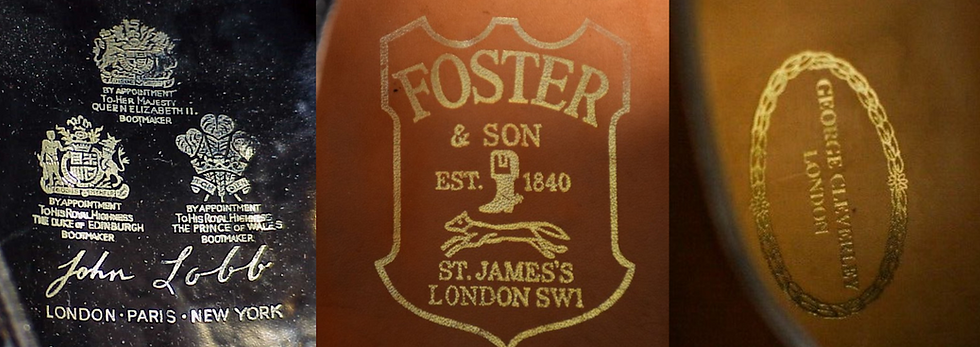The Ten Commandments of Buying used bespoke shoes online
- Sam
- Dec 19, 2020
- 4 min read
Updated: Apr 28, 2021
First things first - are you sure you want to do this? It can be a bit of a pain to be honest - way more inconsistent than buying RTW shoes, and often more expensive. Sometimes the shoes smell weird. It's a whole minefield, frankly.
But the allure of buying bespoke shoes is twofold: firstly, a shoe made exactly to your specifications and dimensions; secondly, a shoe made to the highest and most exacting standards of the craft. Obviously, buying them used makes the first point moot, but the second point is still a compelling one for many.
1. Know the makers. The big (still active) British names are G.J. Cleverley, Foster & Son and John Lobb, so these are what you should be scouring eBay for. These are the most recognisable forms of their logos:

2. Know the sub-brands. All of the bespoke makers above have or have had RTW sub-brands and collections (or just confusing brand name overlaps with other companies, as with John Lobb). Foster & Son RTW, for example, was historically made by Crockett & Jones. Sellers will often mistake or mix these up, and it can be legitimately confusing.
George Cleverley's has a number of sub-brands. One of these is made by Crockett & Jones, but the "Anthony Cleverley" line are (or were) made by Gaziano & Girling, so extremely well made but still RTW. This doesn't mean you should write these sub-brands off - sometimes the actual build quality can be the same as bespoke, just made to a standard-sized last (as with Foster & Son's new RTW collection).
3. Know how to spot bespoke labels. If it has a label identifying size and width like "9.5 D" inside the shoe, it's not bespoke. It's fairly likely that if it has a model name inside then it's not bespoke. Bespoke shoes will generally just have an alphanumeric string used to record the shoe's bespoke last and identify the customer (like A18725) written inside the shoe as well as the maker's logo stamp. Unlike tailoring, they generally won't feature the customer's name.
If you recognise the size markings from a well-known RTW maker (eg. Crockett & Jones) you can also be pretty sure it's not bespoke. The first image below features examples of RTW labels; the second features bespoke labels.


4. Ensure that the seller either takes returns. Honestly, there is probably a 90% chance these shoes won't fit you, so maybe chat with the seller first and ask if you can pay a small restocking fee if they don't normally take returns. An experienced seller will be used to this if they have sold bespoke shoes before.
Or be confident you can recoup the cost through reselling if they won't take it back. On the reselling point, ensure you don't get caught in a bidding war as that can inflate the actual price you can resell for. Bespoke shoes are an interesting example of a product with a massive RRP but often very minimal resale value - see point 10 for more on this.
5. Get the measurements. Ask for an outsole length and width measurement of both shoes and compare them against your own shoes. This isn't perfect - for all sorts of reasons, outsole measurements can vary if the shoes still wear about the same size - but will at least give you a ballpark. The key thing here is that bespoke shoes can be really weirdly sized, so you want to avoid that. It's also vital to ensure they measure both shoes - there can be some real differences in sizing between left and right foot with bespoke pairs.
Note that it is hard to assess the instep on a pair of shoes, but that can be a common point where fit is an issue.

6. Know your feet. Your feet are not exactly the same size - this is normal. Which one is larger? Which is wider? Check that the shoes dimensions reflect the difference.
7. Be sure you actually like how they look. This may sound obvious, but some bespoke makeups can be absolutely hideous (except, presumably, to the person who originally commissioned them). Beauty being such a subjective concept, just be sure you will actually wear them and aren't just drawn in by the allure of bespoke makers. This image is an example of a Made to Order shoe, but I think it represents the kind of... eccentric styling that can crop up.

8. Consider any repair costs. It can be challenging finding a local cobbler to do a hand welted sole replacement - in an ideal world you would send a bespoke pair off to the original maker to be resoled, and although they would do an excellent job, this can be hugely expensive. As with any pair of shoes, check that the leather doesn't have structural damage or tears as well,
9. Embrace failure. It's likely to take a few attempts, so don't think of this as a cost or time-effective way to fill in the essentials of a shoe collection. This is hobbyist-level stuff rather than a sensible way to fill in your shoe rotation.
10. Know your pricing. A lot of sellers will Google the RRP for bespoke shoes and go wild the eBay asking price, but for all the reasons listed above, they can be tricky to sell (and keep sold). As a general rule of thumb, super-luxury products are subject to substantial depreciation, often lucky to return 20% of their original RRP as the eBay selling price - this principle applies to high-end tailoring too. So do a little bit of haggling around price - but don't be a lowballing twit. Nobody likes them.





Comentarios